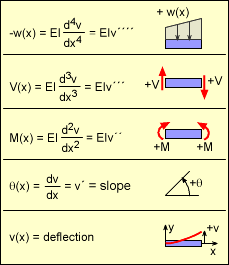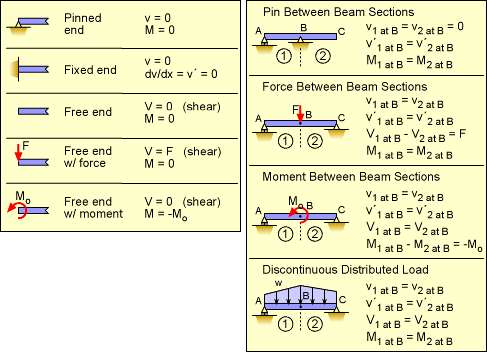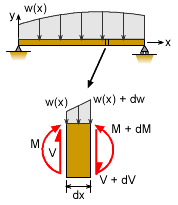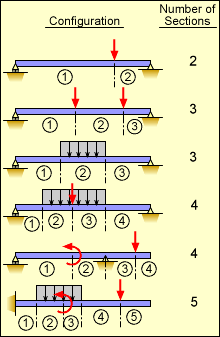| Ch 5. Beam Deflections | Multimedia Engineering Mechanics | ||||||
|
Integration of Moment |
Integration of Load |
Method of Superposition |
Indeterminate Beams |
||||
| Integration of Load Equation | Case Intro | Theory | Case Solution | Example |
| Chapter |
| 1. Stress/Strain |
| 2. Torsion |
| 3. Beam Shr/Moment |
| 4. Beam Stresses |
| 5. Beam Deflections |
| 6. Beam-Advanced |
| 7. Stress Analysis |
| 8. Strain Analysis |
| 9. Columns |
| Appendix |
| Basic Math |
| Units |
| Basic Mechanics Eqs |
| Sections |
| Material Properties |
| Structural Shapes |
| Beam Equations |
| eBooks |
| Dynamics |
| Fluids |
| Math |
| Mechanics |
| Statics |
| Thermodynamics |
| ©Kurt Gramoll |
|
|
||||||||
|
In the previous sections, Integration of the Moment Equation, was shown how to determine the deflection if the moment equation is known. This section will extend the integration method so that with additional boundary conditions, the deflection can be found without first finding the moment equation. |
||||||||
|
|
Moment-Shear-Load Relationships |
|||||||
|
|
When constructing moment-shear diagrams, it was noticed that there is a relationship between the moment and shear (and between the shear and the loading). That relationship can be derived by applying the basic equations to a typical differential element from a loaded beam (shown at the left). First, summing the forces in the vertical direction gives ΣFy = 0 V - (V + dV) - w(x) dx + 0.5 (dw) dx = 0 Both dw and dx are small, and when multiplied together gives an extremely small term which can be ignored. Assuming (dw)(dx) = 0, and simplifying gives,
Next, summing moments about the right side (can be anywhere, but an edge is easier) and ignoring the 3rd order terms gives ΣMright edge = 0 -M + (M + dM) - V dx + [w(x) dx][0.5 dx] = 0 Again, 2nd order terms such as dx2, are assumed extremely small and can be ignored. This gives
Note, capital "V" is shear and not deflection, which is small "v". |
|||||||
|
|
Extending the Deflection Differential Equation |
|||||||
 w, M, V, Slope, and y Relationships and Sign Conventions (Note, w(x) is positice downward) |
Recall, the basic deflection differential equation (Moment-Curvature Equation) was derived as This can be combined with dM/dx = V to give
This equation assumes E and I are constant along the length of the beam section. They can be combined with dV/dx = -w(x) to give
Thus, the deflection can be determined directly from the load function, but it does require four integrations and four boundary conditions. Where as using the moment-curvature equation, only two integrations and two boundary conditions are needed, but the moment equation must first be determined. |
|||||||
| Solving the Load-Deflection Differential
Equation |
||||||||
|
|
The differential equation EIv´´´´ = -w(x) is not useful by itself but needs to be applied to a beam with specific boundary conditions. It is assumed that EI is constant and w(x) is a function of the beam length. The function, w(x), can be equal to 0. In fact, in most situations it does equal 0. For convenience, w(x) is considered positive when acting downward. Integrating the equation four times gives, Each beam span must be integrated separately, just like when constructing a moment diagram. Thus, each new support or load will start a new beam section that must be integrated. Examples of beam sections are shown at the left. |
|||||||
| Boundary Conditions |
||||||||
|
Determining the boundary conditions is usually the most difficult part of solving the deflection differential equation, especially when integrating four times. In particular, boundary conditions for multiple beam sections can be confusing. The basic types of boundary conditions are shown below. Those conditions that require two sections are sometimes called continuity conditions instead of boundary conditions. For example, a point force on a beam causes the deflections to be split into two equations. However, the beam's deflection and slope will be continuous at the load location requiring v1 = v2 and v´1 = v´2. Also, the shear difference will equal the applied point load at that location, and the moment will be equal in both beam sections at that point, M1 = M2. These conditions are needed to solve for the additional integration constants. |
||||||||
 Typical Boundary Conditions (v, v´, V, M) for Beam Sections Using Fourth Order Load-Deflection Equation |
||||||||
| Beam Deflection and Rotation Tool |
||||||||
|
For complex beams with more than a couple loads, determining rotation and deflection is very difficult. Thus, most structural engineers will use a beam analysis tool to calculate the deflection and rotation curves. A simple one, based on finite element method, can be installed on any mobile device for free. . For Android mobile devices, "Beam HPC" calculator, can be downloaded at Google Play. For iOS (Apple) mobile devices, "Beam HPC" calculator, can be downloaded at iTunes. |
|||||||
Practice Homework and Test problems now available in the 'Eng Mechanics' mobile app
Includes over 500 free problems with complete detailed solutions.
Available at the Google Play Store and Apple App Store.


